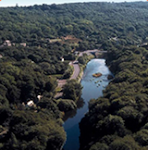Somehow amongst the disaster that has been the weather so far this year we managed to pick a sunny day to start off this season’s series of invertebrate rambles at Lea Quarry, Much Wenlock.
I had continued to use the name “Invertebrately Challenged Tetrad Walks” in previous publicity but have decided that as we are not concerned this season with tetrads that have few invertebrate records I would change the title to reflect what we are actually doing – enjoying looking for invertebrates, studying them, trying to identify them and getting some exercise in pleasant company at the same time. So the walks have been re-branded as “The Joy of Invertebrates” walks.
Five of us gathered in the car park at Edge Renewables in Lea Quarry and were met by their environment officer Katy and her dog Jenny. We donned wellingtons, plenty of warm clothing (although it was sunny there was still a keen wind) and high-visibility jackets and set off to explore the site guided by Katy.
One area of the quarry that is of interest is to the south west which is being left to regenerate naturally following landscaping work last autumn. We visited this area first.
On an earlier visit pit-fall traps had been set up around the base of a young tree that had been left in place during the landscaping. These were emptied and reset. There were not many insects in them but, regrettably, three smooth newts had come to grief. A ground beetle (Pterostichus madidus) was rescued and it quickly disappeared into a crevice in the ground.
Our next activity was to vacuum sample some of the cracks and crevices to see what was lurking out of sight. Unfortunately this did not happen as, on trying to start the engine, the pull-rope broke. Doh! Several not very nice words were muttered. The cracks and crevices had to be searched by hand!
We scoured the area for a while, even eschewing a coffee break, before returning to the car park for lunch. We were able to use some large rocks for seats in the lee of a yew and an unidentified conifer both of which, out of curiosity, we rattled and found a couple of micro-moths overwintering.
After lunch we went in the opposite direction following the path on the northern edge of the quarry returning along the quarry floor. This is the area in which Edge Renewables are hoping to place a Visitor Centre and introduce a public right of way.
An enjoyable start to the season. Thank you to Edge Renewables for permitting access and Katy for her informative guidance.
Unfortunately I forgot to check with our fitness guru on the length of the walk but plotting it out on a map gave a distance of just over 3 miles. I knew you would be interested!
Keith Fewkes

































